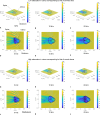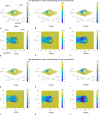Evaluation of fetal exposure to environmental noise using a computer-generated model
- PMID: 40280911
- PMCID: PMC12032418
- DOI: 10.1038/s41467-025-58983-0
Evaluation of fetal exposure to environmental noise using a computer-generated model
Abstract
Acoustic noise can have profound effects on wellbeing, impacting the health of pregnant women and their fetus. Mounting evidence suggests neural memory traces are formed by auditory learning in utero. A better understanding of the fetal auditory environment is therefore critical to avoid exposure to damaging noise levels. Using anatomical data from MRI scans of pregnant patients ( ) from 24 weeks of gestation, we develop a computational model to quantify fetal exposure to acoustic field. We obtain acoustic transfer characteristics across the human audio range and pressure maps in transverse planes passing through the uterus at 5 kHz, 10 kHz and 20 kHz, showcasing multiple scattering and modal patterns. Our calculations show that the sound transmitted in utero is attenuated by as little as 6 dB below 1 kHz, confirming results from animal studies that the maternal abdomen and pelvis do not shelter the fetus from external noise.
© 2025. The Author(s).
Conflict of interest statement
Competing interests: The authors declare no competing interests. None of the contents of this manuscript has been previously published or is under consideration elsewhere. All the authors have read and approved the final version of the manuscript before submission.
Figures








Update of
-
Evaluation of fetal exposure to environmental noise using a computer-generated model.Res Sq [Preprint]. 2024 Nov 25:rs.3.rs-5397645. doi: 10.21203/rs.3.rs-5397645/v1. Res Sq. 2024. Update in: Nat Commun. 2025 Apr 25;16(1):3916. doi: 10.1038/s41467-025-58983-0. PMID: 39649159 Free PMC article. Updated. Preprint.
Similar articles
-
Evaluation of fetal exposure to environmental noise using a computer-generated model.Res Sq [Preprint]. 2024 Nov 25:rs.3.rs-5397645. doi: 10.21203/rs.3.rs-5397645/v1. Res Sq. 2024. Update in: Nat Commun. 2025 Apr 25;16(1):3916. doi: 10.1038/s41467-025-58983-0. PMID: 39649159 Free PMC article. Updated. Preprint.
-
Evaluation of fetal exposure to external loud noise using a sheep model: quantification of in utero acoustic transmission across the human audio range.Am J Obstet Gynecol. 2019 Oct;221(4):343.e1-343.e11. doi: 10.1016/j.ajog.2019.05.036. Epub 2019 May 29. Am J Obstet Gynecol. 2019. PMID: 31152712 Free PMC article.
-
Sound environment of the fetal sheep.Am J Obstet Gynecol. 1990 Jan;162(1):282-7. doi: 10.1016/0002-9378(90)90866-6. Am J Obstet Gynecol. 1990. PMID: 2301503
-
Fetal exposures to sound and vibroacoustic stimulation.J Perinatol. 2000 Dec;20(8 Pt 2):S21-30. doi: 10.1038/sj.jp.7200446. J Perinatol. 2000. PMID: 11190697 Review.
-
[The fetus and noise].Gynakol Geburtshilfliche Rundsch. 1997;37(3):119-29. doi: 10.1159/000272841. Gynakol Geburtshilfliche Rundsch. 1997. PMID: 9483870 Review. German.
References
-
- Jauniaux, E., Wylie, B. J., Verheijen, E., Conry, J. & Papageorghiou, A. Women’s health in the anthropocene. BJOG: Int. J. Obstet. Gynaecol.131, 531–532 (2024). - PubMed
-
- World Health Organization. Environmental Noise Guidelines for the European Region (World Health Organization, 2018).
-
- European Environment Agency. Healthy Environment, Healthy Lives: How the Environment Influences Health and Well-Being in Europe (European Environment Agency, 2020)
MeSH terms
Grants and funding
- EP/P013309/1/RCUK | Engineering and Physical Sciences Research Council (EPSRC)
- BB/Y514214/1/RCUK | Biotechnology and Biological Sciences Research Council (BBSRC)
- NS/A000027/1/RCUK | Engineering and Physical Sciences Research Council (EPSRC)
- EP/P012434/1/RCUK | Engineering and Physical Sciences Research Council (EPSRC)
- MR/X010007/1/RCUK | Medical Research Council (MRC)
LinkOut - more resources
Full Text Sources
Medical
Miscellaneous

